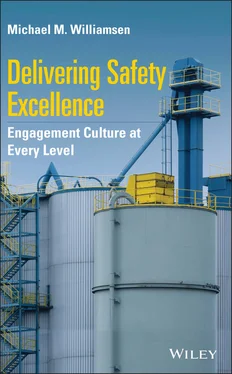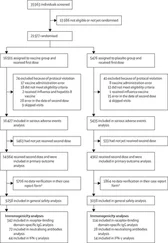The good news is that after about nine months of using this approach, improvements begin to take hold, performance improves, and the culture begins to make a notable shift. Quietly and methodically over time the “Cavemen” no longer have the upper hand. The 90% follower group begins pushing back when told to resist change, and they slowly become advocates of improving the organization and its efforts. The needed sea change will then be visibly and palpably upon you when we (both hourly and salaried leadership) engage our people in focusing on and fixing what they know to be wrong, while we let the flak throwers fade into the background. It is like driving a vehicle which requires concentration and attention on the road ahead (the goal) because no progress is made while concentrating only on a rearview mirror!
While all this build up work to improvement is going on, the 800 pound production/operations gorilla always takes precedence. There are numerous examples of dangerous shortcuts which are taken in the field to get production/customers back on line. Aaron thinks back over the last year's injuries and ticks off more than a dozen of these aggravating, painful examples. All are indicators of the weak safety culture that exists at every level of the organization. None of the parties in his organization are without blame, all share a piece of the blame, including Aaron's safety department.
Yet there must always be time made available for the ineffective, boring, regulatory required safety training done by boring, poor performing safety trainers. And when things go wrong because there was not time to do the job right, there always seems to be time to redo what should have been done correctly the first time. These frustrations will continue to occur, but at a lesser frequency after nine and more months of fixing stuff people have been accustomed to just living with. And of course there is more bad news; while in the embryonic state of organizational culture improvement, injuries will stop production/operations. In turn, these happenings will always put the safety department in the role of the safety cop bad guy.
The ROI matrix is a useful tool. However, it takes serious leadership to engage in this kind of journey that lights a fire for improvement. The Doc closed this time together with a challenging thought/concept; “Management is lighting a fire under someone. Leadership is lighting a fire in someone.” “The ROI matrix approach is an important first step for an organization to develop the leadership that can replace a culture of ineffective management.”
Aaron hangs up the phone and goes for a walkabout at a few of the company's field locations while he cogitates about all the input teachings he has just received. That evening he strikes a small smile as he quietly tells himself; “It's time to suck it up buttercup!” And thus, the next day Aaron decides to act, and then he begins building his case to implement a change in his company's culture. Therefore, he begins sketching out a mental plan to develop interactive, original training which satisfies the legal requirements and also engages the hourly employees. In the background he quietly tells himself: “Great idea, but how am I going to do this with no significant safety budget, no significant hourly or salaried leadership that is supportive, and a cadre of strong resisters/cavemen who roadblock my attempts for safety improvement?” “I guess it's time to break out the Action Item Matrix (Figure 2.1a and b ) and bring my team to an ROI matrix (Figure 3.1) brainstorming event.”
Aaron pauses before diving into the long “to do list.” There is still one immense obstacle to overcome: a total lack of management participation. He remembers the Doc telling him about the few Critical Success Factors (CSF) which determine management pay, and therefore drive its active participation. At Aaron's organization the big three management Critical Success Factors are all wrapped up in the operations indicators of cost, quality and customer service .
Aaron recognizes that before he gets totally engaged with the AIM and ROI matrix tasks he needs to have a parallel tactic which will engage upper management in improving the safety culture. But how can he affect management pay when it comes to safety? It's time for another two hour phone discussion with the Doc .
The Doc reminisces about his being the new “safety guy” working with the famous and very experienced safety consultant, Dr. Dan Petersen (see appendix Bfor details). Immediately upon hiring Dr. Dan as the safety consultant, the Doc was exposed to an incredible amount of new material engineers were not taught in a university curriculum. After 42 years in safety Dr. Dan Petersen, who is often referred to in trade publications as a “safety guru,” concluded that safety incidents were due primarily to management and management system failures. In his mind OSHA was not at all the culprit that upper management often thought them to be. OSHA was doing their job of providing a focus on the conditions that have often led to serious injuries and fatalities. However, management was another issue altogether and thus to quote an old‐time cartoon character Pogo Possum, “We have met the enemy and they are us.” 1 Dr. Petersen explained his safety philosophy as being centered on leadership and accountability as the way to develop an organization's culture of safety. In a 1996 interview with EHS (Environmental Health and Safety) Today magazine, Petersen said that managers must learn that they have to do things on a regular basis to develop the culture which produces safe behaviors. He went on to profess that he did not know what those things were, but that organizations must unleash their management skills on safety problems.
One of Dr. Dan's many paradigms was: “What gets measured is what gets done and what gets rewarded is what gets done first.” Back then, when the Doc was newly in charge of safety for a Fortune 20 company, upper management was paid significant bonus dollars for excellent performance in cost, quality, and customer service. There was no incentive for safety performance and consequently very little attention paid to personnel safety numbers. Neither the Doc nor Dr. Petersen were proponents of safety bonus payments based on injury rates, the lagging indicators which are driven by what you do not want to occur. However, back at that time leading indicators were almost unheard of, so the safety culture improvement group did develop a simple bonus structure which gave significant emphasis on reducing injuries at the plant manufacturing level. In the past, 1/3 of the bonus pool was being paid out for excellent performance in each of cost, quality, and customer service objectives. The new plan, approved by an upper management which wanted to end their miserable safety culture, was 25% of the bonus pool for excellent performance in each of cost, quality, customer service, and safety culture and injury rate objectives. The safety incentive system was based on:
Practical, effective safety accountabilities for all employee levels of the operations groups in manufacturing facilities.
The implementation of a continuous improvement culture which engaged hourly and salaried employees in fixing whatever was not believed to be correct, or was complained about, with respect to safety.
A safety work order system which dedicated the necessary resources to fix condition issues.
An audit system which was not based on the typical OSHA paperwork approach. Rather, there were open‐ended interviews with hourly and salaried employees which got to the core of safety accountabilities being regularly and credibly performed by all levels of personnel at the facility. The audits also included some records of safety continuous improvement/kaizen teams and safety work order attention and closure.
Читать дальше












